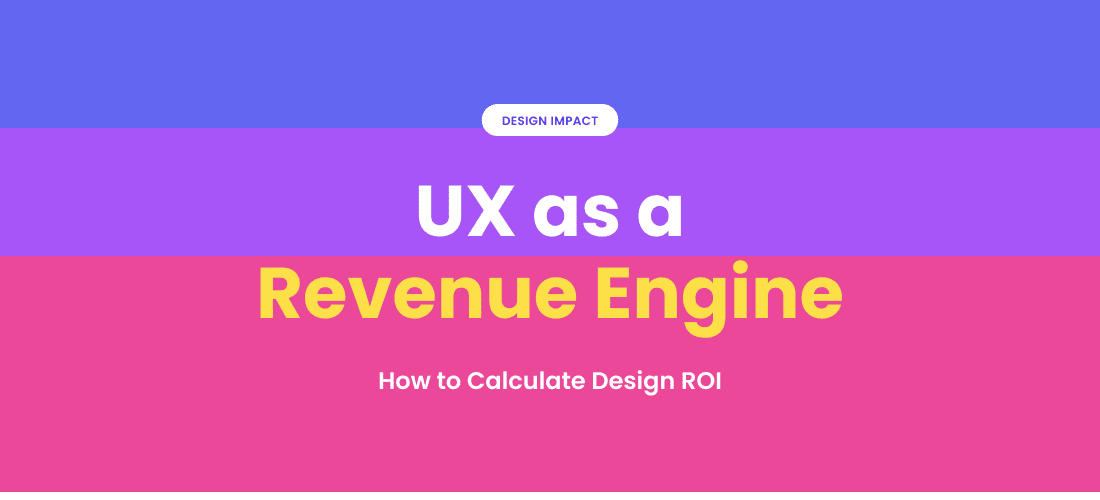Nov 28, 2025

For too long, UX design has been viewed as a cost center, a nice to have that makes products prettier but doesn’t directly contribute to the bottom line. That perspective is not only outdated; it’s costing companies millions in lost revenue.
The reality? Best UI/UX design is one of the most powerful revenue drivers available to modern businesses. Companies that prioritise UX see conversion rates increase by up to 400%, customer acquisition costs drop by 50%, and customer lifetime value soar by 2-3x. Yet most executive teams still struggle to quantify design ROI and justify UX investments with hard financial data.
This blog is your executive playbook for calculating design ROI, building a business case for UX investments, and transforming UX from a cost center into a measurable revenue engine. Whether you’re a CEO, CFO, or Product Executive, you’ll learn the frameworks, formulas, and real-world examples that prove UX design directly impacts your company’s financial performance.
Traditional finance models categorise UX design as an operational expense. But forward-thinking companies have reclassified it as a strategic investment , one that generates measurable returns across every stage of the customer journey.
Consider this: According to Forrester Research, every $1 invested in UX returns $100 in ROI. That’s a 9,900% return. McKinsey reports that design-led companies outperform their competitors by 2:1 on revenue growth. These aren’t vanity metrics, they’re board-level financial indicators.
The UX ROI Calculator: Step-by-Step Formula
Calculating design ROI requires measuring the before-and-after impact of UX improvements on key revenue metrics. Here’s the foundational formula:
Design ROI = [(Revenue Gain from UX Improvements – UX Investment Cost) / UX Investment Cost] × 100
But this is just the starting point. Let’s break down how to measure each component.
Before any UX work begins, capture:
– Conversion rate (trial-to-paid, checkout, signup)
– Average order value (AOV) or deal size
– Customer lifetime value (LTV)
– Customer acquisition cost (CAC)
– Time to first value
– Support ticket volume
– Churn rate
Revenue Uplift Formula:
Revenue Uplift = (Post-UX Conversion Rate – Pre-UX Conversion Rate) × Traffic × AOV
Example: An e-commerce site with 100,000 monthly visitors, $150 AOV, and a baseline conversion rate of 2% generates $300,000/month. After UX improvements, the conversion rate increases to 2.7%.
Revenue Uplift = (2.7% – 2.0%) × 100,000 × $150 = $105,000/month or $1.26M annually.
Better UX design reduces customer acquisition costs by improving organic conversion, reducing paid ad spend waste, and increasing word-of-mouth referrals.
CAC Reduction Formula:
CAC Savings = (Pre-UX CAC – Post-UX CAC) × Number of New Customers
If CAC drops from $120 to $85 after UX improvements, and you acquire 5,000 customers annually:
CAC Savings = ($120 – $85) × 5,000 = $175,000/year
UX improvements that reduce churn directly increase LTV.
LTV Impact Formula:
LTV Increase = (Post-UX LTV – Pre-UX LTV) × Customer Base
If LTV increases from $2,000 to $2,400 for a base of 10,000 customers:
LTV Increase = ($2,400 – $2,000) × 10,000 = $4M in additional lifetime value
Case Study 1: SaaS Platform Onboarding Redesign
– Challenge: 60% drop-off during onboarding
– UX Solution: Implemented progressive onboarding with contextual tooltips
– Result: Trial-to-paid conversion increased from 12% to 18% (+50%)
– Revenue Impact: $2.1M additional ARR
– Design Investment: $120K
– ROI: 1,650%
Case Study 2: E-Commerce Checkout Flow Optimization
– Challenge: 68% cart abandonment rate
– UX Solution: Simplified checkout from 6 steps to 2, added trust signals, implemented auto-fill
– Result: Checkout completion rate increased from 32% to 47%
– Revenue Impact: $4.8M additional annual revenue
– Design Investment: $85K
– ROI: 5,547%
Case Study 3: B2B Dashboard UX Overhaul
– Challenge: High support costs, low feature adoption
– UX Solution: Redesigned information architecture, added contextual help, improved data visualization
– Result: Support tickets reduced 42%, feature adoption increased 60%
– Cost Savings: $320K/year in support costs
– Revenue Impact: $1.2M from increased upsells
– Design Investment: $150K
– ROI: 913%
How Product Executives Can Justify UX Spend
When presenting UX investments to the C-suite, use this framework:
Your proposal should include:
– Executive Summary (problem, solution, expected ROI)
– Current State Analysis (baseline metrics, pain points)
– Proposed UX Improvements (scope, timeline, deliverables)
– Financial Projections (revenue uplift models, cost-benefit analysis)
– Risk Mitigation (pilot testing, phased rollout)
– Success Metrics (KPIs, tracking plan)
To ensure your UX investments deliver maximum returns:
UX design is no longer a nice-to-have—it’s a revenue engine that directly impacts your bottom line. Companies that calculate design ROI and treat UX as a strategic investment consistently outperform competitors who view it as a cost center.
The frameworks, formulas, and UX case studies in this guide give you everything you need to build a compelling business case, measure impact, and justify every dollar spent on UX design. Whether you’re optimizing conversion rates, reducing CAC, or increasing LTV, the path to revenue uplift through UX is clear, measurable, and repeatable.
If you’re a CEO, CFO, or Product Executive ready to treat UX as a revenue engine, follow this action plan:
Audit Current UX Performance
Calculate Potential ROI
Benchmark Against Competitors
Prioritize High-Impact UX Projects
Build a Data-Driven Business Case
Assemble the Right Team
Set Up Tracking Infrastructure
Run Pilot Projects
Make UX a Board-Level Priority
Commit to Continuous Optimization
The bottom line: UX design isn’t just about aesthetics—it’s about revenue, retention, and sustainable growth. Use this guide to calculate design ROI, build your business case, and transform UX into your company’s most powerful revenue engine.